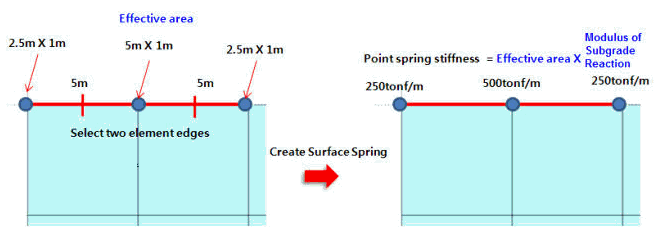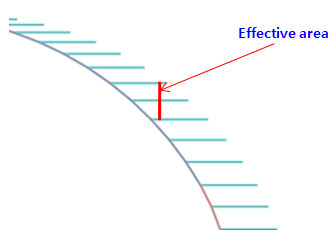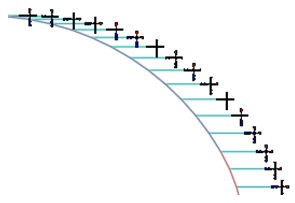Surface Spring
To create a Surface Spring element for an Analysis Model.
Elastic boundary (spring) element is mainly used to consider the stiffness of adjacent structures or ground at the boundaries of a model. Surface Spring is especially designed to readily model surface boundary conditions for curved or planar structures in contact with ground.
Surface elements are selected and the modulus of subgrade reaction for unit area is entered. The stiffness of the spring at each node pertaining to the effective (tributary) area is calculated by the product of the effective area and the modulus of subgrade reaction. If the support such as the ground needs to resist only compression, select Elastic Link (Compression-only) and enter the modulus of subgrade reaction.
Applicable Modules:
Ground
|
Slope |
Soft Ground |
Foundation |
Seepage |
Dynamic |
From
the Main
Menu, select Model
> Element > Surface Spring ![]()
From the Command Line, type 'SurfaceSpring' or 'CESS'
Mesh Set
Enter the name of the mesh set. Click
to  Add, Modify
or Delete mesh sets.
Add, Modify
or Delete mesh sets.
Object
Type
Select the object for which surface spring will be created.
Frame
Element Boundary
Element Width
Support stiffness is calculated from the effective (tributary) area (width x tributary length).
Conversion
Spring
Surface Spring is converted to Spring.
Modulus of Subgrade Reaction
Kx and Kz in each direction.
Damping Constant/Area
Enter the damping constants in two directions when viscous boundary is generated.
Elastic Link
Spring is converted to Elastic Link.
Direction
Select the direction of the elastic link.
Modulus of Subgrade Reaction
Ground stiffness per unit area.
Element Length
Length of elastic link.
Tension only
Only tension stiffness exists.
Compression only
Only compression stiffness exists.
![]() The dialog box will be initialized.
The dialog box will be initialized.
![]() After creating the pile elements, the dialog box will close upon
clicking.
After creating the pile elements, the dialog box will close upon
clicking.
Click ![]() or press the ESC key to close the dialog box. .
or press the ESC key to close the dialog box. .
![]() After
creating the surface spring, the work process will switch to the
state of Select 1D Element upon clicking.
After
creating the surface spring, the work process will switch to the
state of Select 1D Element upon clicking.
Note:
Spring is created from the effective area of a node multiplied by the modulus of subgrade reaction. The diagram below illustrates the creation of surface spring at the boundaries of 2 square elements with each side being 5m long. The effective areas are 2.5m^2 each for the first and last nodes and 5m^2 for the center node. With the modulus of subgrade reaction, 100tonf/m^3, the converted spring stiffness is calculated by multiplying the effective areas by the modulus of subgrade reaction, resulting in 250tonf/m for the end nodes and 500tonf/m for the center node.

Elastic Link – Creating elastic links from selecting Frame/Element Boundary is identical to the Spring conversion method. Elastic link is often used for lining structural analysis as a boundary condition and as such Elastic Link is often created on curved elements. As shown below, the effective areas for nodes on the curved elements are calculated on the basis of ΔZ (difference in height between two nodes) rather than the actual length, ΔL, when creating Elastic Links on the curve in the X-direction.

When surface spring is created as elastic link, Compression-only or Tension-only may be selected.

Elastic Link can be created in the Global +X, -X, +Z, -Z and Normal(+,-) directions.